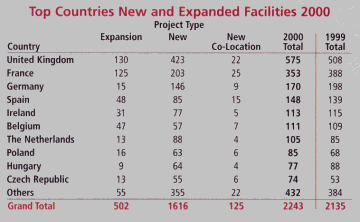
L |
ONDON — The United Kingdom retained its title in 2000 as the continental leader in inward investment for new and expanded corporate facilities in Europe, according to data supplied by
Ernst & Young’s European Investment Monitor.
The London-based EIM, a product of E&Y’s International Advisory Services’ database, reports that the number of foreign direct investment (FDI) projects in Europe increased by 5 percent in 2000 to 2,243 projects. The UK experienced an increase of 13 percent — from 508 projects in 1999 to 575 in 2000, with its share of Europe’s total increasing to 26 percent of all FDI projects.
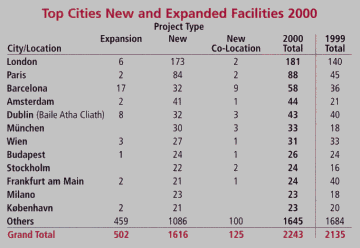
The UK’s nearest rival, France, accounted for 15 percent of all continental projects, at 353. Germany finished third at 170, Spain fourth at 148 and Ireland fifth at 113. Rounding out the top 10 European countries for FDI projects were Belgium (111), the Netherlands (105), Poland (85), Hungary (77) and the Czech Republic (74).
Despite the UK’s dominance of European markets, there are some risks associated with the country’s growth in the past year, says Mark Hughes, corporate location adviser with Ernst & Young in London. “The UK recovered its market share on 1999’s figures when inward investment into manufacturing was hit,” Hughes says. “Foreign direct investment in telecoms, software and business services has taken up the slack. Technology sectors are fragile and much of that sector’s investment has come from the United States. If the U.S. does retrench as a result of a downturn or a halt in growth, the UK will suffer, probably moreso than the rest of Europe because of its dependence on the U.S. and these service sectors.”
France No. 1 in New Manufacturing Projects
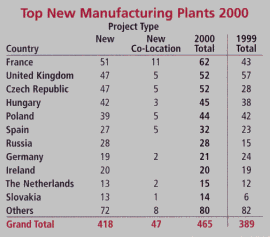 The largest single activity among FDI projects in Europe last year was manufacturing. Concentrated on automobiles, chemicals, electronics and food, manufacturing facilities accounted for 827 of Europe’s total or nearly 37 percent of all inward investment.
The largest single activity among FDI projects in Europe last year was manufacturing. Concentrated on automobiles, chemicals, electronics and food, manufacturing facilities accounted for 827 of Europe’s total or nearly 37 percent of all inward investment.
France flexed its newfound muscle in this area by overtaking the UK for the No. 1 ranking in new manufacturing plants in 2000, with 62 such facilities to the UK’s 52. Last year, the roles were reversed, with the UK leading the 1999 race 57 to 43.
The productivity of France’s labor force plays a large role in its success in winning such investments. According to the Organization for Economic Cooperation and Development, the average French worker in 1973 produced 73 percent as much each hour as his or her counterpart in the U.S. By 1987, that figure grew to 99 percent and by 1999 it had increased to 108 percent.
“France has changed drastically,” Hirami Suzumura, vice president of Toyota Motor Europe, told Bloomberg News last year. “They realize that they can’t close themselves off from what is happening in the rest of the world.”
While Europe’s total number of new manufacturing projects increased from 389 in 1999 to 465 last year, the number of expansions and co-locations (new activities added to an existing company’s site) decreased. This resulted in a net 10 percent decline in projects from 918 in 1999 to 827 in 2000 — and the UK is enjoying an even smaller slice of that pie, according to E&Y. Total manufacturing plants in the UK declined by 16 percent from 151 in 1999 to 127 in 2000.
Surprise entries moving up the top 10 list of countries with new manufacturing plants were three Central and Eastern European nations: the Czech Republic (tied with the UK for second place with 52 projects), Hungary (fourth with 45) and Poland (fifth with 44).
“With Poland and the Czech Republic enjoying such large increases in new manufacturing projects, it would be easy to argue that they are just going to low-cost locations,” says Hughes. “But the fact that France — which is not a low-cost territory — has seen such a strong increase in new manufacturing projects shows that infrastructure, Eurozone stability, skills and market access are also powerful influences.”
Is the UK Over-exposed to U.S. Investment?
The leading source of FDI into Europe is the U.S., which was responsible for 44 percent of all projects in 2000 (up from 35 percent in 1997). The UK and Ireland have become increasingly reliant on American capital, which accounted for 57 percent and 70 percent, respectively, of their inward investment projects. In both Germany and France, U.S. dollars accounted for 44 percent of all FDI projects.
The U.S. economic slowdown serves as a timely reminder of the importance of intra-European investment, according to Hughes. “To counter over-dependence on the U.S., the UK would do well to target projects from Western European countries as much as it does those from North America,” he says. “Continental development agencies have already recognized this and heavily target UK companies. The UK should do the same on the continent.”
Adding to the UK’s fragile position is the fact that much of the country’s growth in FDI plants came from the suddenly volatile information technology sectors of telecommunications, software development and dot-com firms.
“In the longer term, the UK should focus on trading up in value — that is, salaries, skills, technology and knowledge,” says Hughes. “The UK should look at the growing number of global projects — global R&D centers or headquarters, for example. These projects are high in value and are attracted to locations with highly skilled work forces, a strong knowledge base, advantageous tax regimes and good international links.”
Global Players Dominate Foreign Investment
Of the 1,612 companies that undertook FDI projects in Europe last year, 100 firms accounted for 25 percent of these plants. Siemens maintained its No. 1 company ranking in 2000 from 1998 and 1999, while multinational giants IBM and IKEA cracked the top 12 for the first time.
Global players in the new economy — Siemens, IBM, Philips, GEC, Sony, Colt Telecom and Deutsche Telekom — all ranked among the top 12 investing companies. Among the global automotive firms, Ford, DaimlerChrysler and Volkswagen all undertook significant capital investments in Europe last year. Ford and DaimlerChrysler tied for second on the list, while Volkswagen finished eighth.
The growth of the automotive sector came as especially good news for Italy, where General Motors and Fiat recently announced they will form an industrial alliance that will have a lasting impact on the Piedmont or Northwest region of the country. The alliance will specialize in the production of engines and parts.
“The agreement with GM and Fiat is a positive and represents a huge opportunity for growth,” says Enzo Ghigo, president of the Piedmont region of Italy. “It confirms that the automotive sector is one of the major factors in our economic development.”
But Italy is not the only place on the continent benefiting from the influx of new car plants. In Sunderland, England, Nissan Motors announced last year that it is making a US$300 million investment at its existing operation on England’s northeast coast. As a result, the Sunderland-built Nissan Micra automobile will be the first car built around a common Renault-Nissan platform.
“As you know, Sunderland is the leading car plant in terms of productivity and has been in that position for many years,” Nissan CEO Carlos Ghosn noted last year in announcing the location decision. The expansion makes Sunderland the site of the largest auto plant in Europe, with annual output rising from 330,000 to 500,000 vehicles a year.
‘Super League of Cities’ Forms on Continent
Thirteen European areas (cities or geographic regions) secured 32 percent of all FDI projects, an increase from 25 percent in 1999. Greater London and the Ile de France areas attracted 182 and 99 projects, respectively, among business services, telecommunications, software, financial services, headquarters, and sales and marketing facilities.
The remainder of the top 13 regions included Catalonia (91 projects), Amsterdam (57), Dublin (47), Bavaria (42), Berkshire (41), Provence-Alpes Cote d’Azur (33), Vienna (32), Lombardy (30), Budapest (26), Alsace (27) and Hessen (27).
Dublin maintains a strong profile in software, while Stockholm and the Cote d’Azur have developed strong clusters of information and communications technology design centers. Ireland, Scotland and the Netherlands remain the focal point for customer contact centers, also known as call centers.
Recently, the Netherlands has scored several major successes in attracting high-tech employers. TyCom, a leading builder of worldwide undersea fiber-optic cable networks, decided to bring a major link in its network onshore at Eemshaven. The company will invest $100 million over the next two years to develop a digital hub in Groningen.
ThruPoint Inc. opened a regional headquarters office in Amsterdam because of the high-tech growth potential of the Netherlands. According to The Gartner Group’s Dataquest, the annual internetworking market in the Netherlands is estimated at $2.9 billion. That figure is expected to increase 124 percent by 2004 to a market size of $6.5 billion.
News like this is making Amsterdam part of the new European “super league of cities,” according to Ernst & Young. Amsterdam, London, Paris, Barcelona and Dublin collectively increased their market share of all FDI projects from 14 percent in 1999 to 18 percent in 2000. These super-league cities are all developing high-tech clusters in the fields of software development, telecommunications and business services.
Hughes notes that while there is extensive clustering in key growth sectors, economic development agencies outside of these regions can still score gains. For example, he cites the Oresund region (Copenhagen-Malmo) of Denmark and Sweden, which has redefined its business strengths by linking its cities with a bridge and doubling its critical mass to 3.5 million people.
“Property and land availability, low labor costs and incentives are no longer enough,” Hughes contends. “New economy businesses prize ‘connectivity’ — international transport, electronic infrastructure and networks of people with complementary skills.”
Other major findings of the Ernst & Young EIM annual report include:
- France retained its overall lead among European countries attracting logistics facilities in 2000, with 27 logistics plants compared to No. 2 UK’s 18. The Netherlands, capitalizing on its strong transportation infrastructure, moved up the chart from sixth place in 1999 to third place in 2000.
- The UK remains foreign investors’ top choice for headquarters facilities. A whopping 94 projects came to the UK in this category in 2000, up from 63 such facilities in 1999. No other European country was even close, as Germany finished second with 13 headquarters projects.
- The UK still dominated the call center market, securing 33 inward investment projects in this sector last year, up from 27 in 1999. Second place went to France (14 projects), which moved up from the fifth spot in 1999. Italy, which posted only one call center project among FDI investments in 1999, increased its total to four in 2000.
- Research and development projects continue to flock to the UK. Some 37 such facilities selected the UK as home in 2000, down from 1999’s tally of 45 but still well ahead of second-place France’s 18. Ireland defended its third-place ranking with 17 foreign-owned call centers last year.
- The UK had little competition for its No. 1 spot among top locations for sales and marketing facilities. The UK tallied 198 such centers in 2000, up from 1999’s mark of 146. Second place went to France, with 85 sales and marketing facilities, ahead of third-place Germany’s 75.
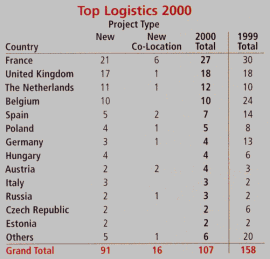
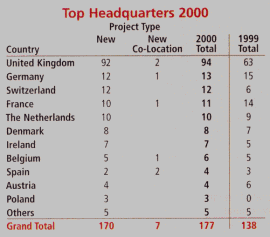
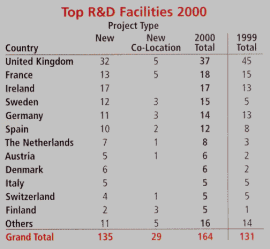
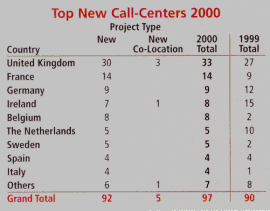
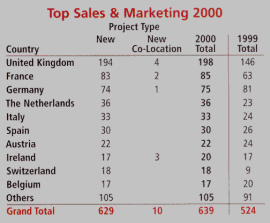
Continue to sidebar: European New Plant Information Goes Online

